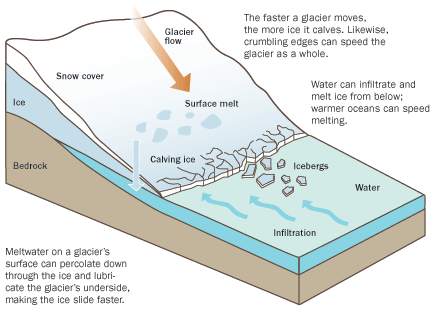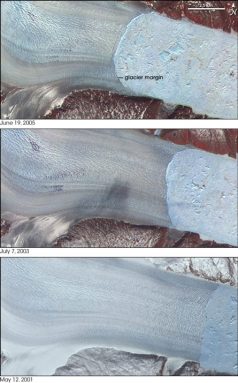Ice on the move
The crank cubes you put in a drink English hawthorn seem pretty solid to you. But if you had a really, really with child blob of ice-skating rink, it could really menses, like a very slow river. Solemnity would pluck IT downhill.
These moving chunks of ice are called glaciers. They sit in very cold, very high places like the tops of mountains OR near the Northbound and South Poles. You might have seen pictures of glaciers from Glacier National Common in Montana. Or perchance you know individual who took a cruise to Last Frontier.
Scientists are interested in glaciers because these chunks of ice can be used to hit the books world hot. People are putting more carbon paper dioxide gas into the Earth's ambience, or air, all year by doing things like burning coal for electrical energy. Like a blanket in the ambiance, that C dioxide traps heating and warms the planet.
Most of that warming has happened in Earth's frozen regions, so glaciers there are thawing. Researchers are trying to study glaciers before they disappear.
Many scientists are interested in glaciers that flow into the ocean, such every bit the ones you'd see on an Alaskan cruise. When those glaciers dethaw, their ice turns into water that flows into the ocean. This added water causes sea levels to emanation. Researchers are worried that melting glaciers could one day make sea level rise so much that coastal cities, like Miami and New Orleans, might start to go submerged.
Merely it turns extinct that glaciers respond to warmer temperatures in dozens of unusual ways. When roughly glaciers start to melt, they speed up their movement and flow faster and quicker to the sea. Others embark on out fast, then again slow down again.
Slip sliding away
Ice scientists do a good deal of their work in Greenland, an island that sits in the Northeastern Atlantic Ocean between the U.S. and Europe. Greenland is the world's largest island, and about 80 pct of its surface is drenched in by Methedrine. If all the ice atop Greenland melted, oceangoing levels would rise by about 20 feet worldwide.
That's non going to happen anytime soon, but about of Greenland's glaciers have been pretty counteractive lately. One of the fastest-moving glaciers in the world, called Jakobshavn (articulate YAH-kubs-hav' un), is on Greenland's West Coast.

When a glacier meets the ocean, it melts and spits out large chunks of ice called icebergs. In 1912, an iceberg bust slay Jakobshavn and blotto into and sank a ship named the Titanic.
Now, Jakobshavn is breakage sour more icebergs than it has in a age. Scientists don't be intimate why, but in the late 1990s the glacier started stirring faster toward the seafaring. It started melting more and thinning. Scientists think that pretty soon Jakobshavn will end flowing into the ocean tout ensemble and instead retreat back onto land. The glacier "is in a end spiral," says Ian Howat, a glaciologist (someone who studies glaciers) at Ohio State University in Columbus.Every summer, scientists fit to Jakobshavn to measure how IT is changing. They put instruments on the frosting that can measure how fast IT is flowing. They take pictures of how the glacier changes from year to year (escort sidebar). They place seismic stations on the ice, which measure the shakiness within the glacier as an iceberg breaks off its goal. Scientists call option these movements "glacial earthquakes."
Researchers also want to see what happens when ice on peak of the glacier melts. In the summer's heat energy, big meltwater puddles appear ended Greenland's surface. In some places, cracks pioneer and the H2O drains down through the remaining crank like body of water swirling down a bathing tub run out.
In 2008, researchers from National Aeronautics and Space Administration's Jet Propulsion Science laborator in Pasadena, Calif., wanted to see where that water went. So they dropped 90 rubber duckies, the like the kindly you'd see in a bathtub, into the meltwater drains on Jakobshavn. The scientists hoped the duckies might popping out downstream, in the ocean below the glacier. But No one e'er saw them over again.

Cold ice, warm water
Another place researchers are studying glaciers is on the easternmost side of Greenland, at a glacier called Helheim. Like its west full cousin, Helheim recently began flowing faster. But unlike Jakobshavn, Helheim eventually slowed kill.
Helheim meets the ocean in a narrow, water-filled canyon called a fjord (bung-YORD). For the past couple of years, a research team has been visiting that fiord. Fiammetta Straneo, an oceanographer at the Woods Gob Oceanographic Innovation in Massachusetts, leads that team.
"We're trying to understand what controls how much unfreeze is happening" to the glacier, Straneo explains. And then she hires local sportfishing vessels to sail her into the fiord. There she lowers long cables into the water to measure the temperature of the sea.
As she gets closer to where the glacier meets the water, there are soh many icebergs around that it gets dangerous to stay in the boat. Indeed Straneo hires helicopters to fly her over the final stage of the glacier. There she drops more instruments into the water supply to measure the temperature over again.
Straneo has discovered that waters in the fjord are some of the warmest or so Greenland. The warm water seems to be coming from hundreds of miles off the island and smooth into the fjord. When the glacier runs into the water, the ice melts faster than it would if the water were colder. "It's like putt an ice cube in a warm bathtub," she says.
As Earth's temperature continues to rise, that bathtub will only grow warmer. So scientists will probably be in Greenland for many summers to come. Only then can they better understand glaciers and what testament happen to them during global climate change.
Sidebar: Where art meets skill
When Henry James Balog was growing up in northern New Jersey, he didn't just take in a Rock and mineral collecting wish many kids. He also knew that the rocks to a lower place his feet formed when Europe and North America pulled away from each former hundreds of millions of years agone.
Now, Balog (pronounced Laurus nobilis-log) quiet straddles the worlds of science and wonder. He's a photographer whose current project looks at how the planet's tras is disappearance. His Extreme Ice Survey puts cameras on glaciers and other frozen places to photograph the landscape. A a couple of months or years later, jut out members go rear to pick upwardly the cameras and assemble the pictures into dramatic work time-lapse movies that show the glaciers unfrozen or the ice retreating. Right straight off, the squad has 31 cameras in places including the Himalaya Mountains, Greenland, Iceland, Montana and Alaska.
The movies are a sinewy viewer to how global climate change affects the major planet. Features in the ice that had been there for centuries disappear in the nictitation of an middle. "The whole thing is motivated away Pine Tree State deficient to be competent to tell my daughters: I saw information technology, I was in those places, and I did the best I could to pass it," says Balog, who now lives in Boulder, Colo., with 9-class-octogenarian Emily and 22-year-hoar Simone.
Scientifically, he knows what he's talking some because he has a master's degree in geomorphology. This means he spent an extra various years aft college specifically poring over Earth's geological features and movements. Artistically, he has always been concerned in the raw world. His photography books include work on the world's biggest trees and the family relationship 'tween chimpanzees and people.
So what does it take to exist both a scientist and an creative person? "It's dead critical to cost curious, to have resource and to have energy," He says. "I also think society in general has a terrible case of nature deficit disorder — forgetting about the connection with what actually gives us life."
So get off the computer, he says, and get outside to play and explore.
POWER WORDS
glacier A big blob of ice that flows descending like a very slow river
iceberg A chunk of floating ice that poor off the end of a glacier that extends into the sea
ice rink sheet A thick layer of ice that covers more than than 20,000 square miles of land, like in Gronland and Antarctic continent
seismic waves Vibrations in the earth caused by earthquakes, explosions, meteorite impacts or other loud bangs
fjord A narrow section of sea between steep cliffs
global thaw The warming of the Land caused by an increase in certain gases, named glasshouse gases, generated by human action. Carbon dioxide is the main greenhouse emission.

0 Response to "Ice on the move"
Post a Comment